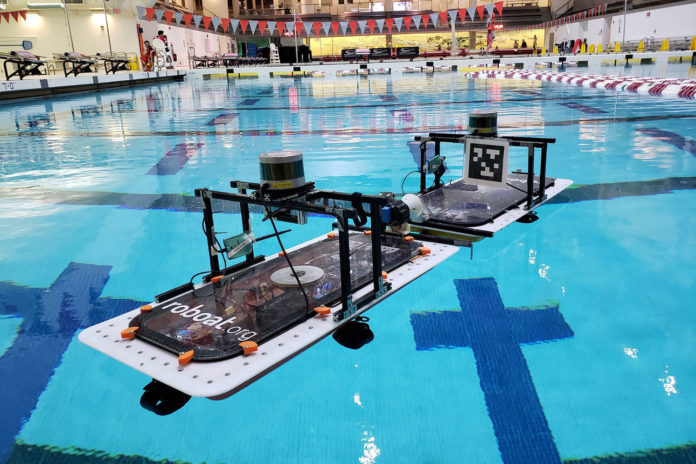Several years ago, MIT and the Amsterdam Institute for Advanced Metropolitan Solutions (AMS Institute) teamed up on the “Roboat” project. The actual idea was to design a fleet of self-piloting mini robot boats equipped with sensors, thrusters, microcontrollers, GPS modules, cameras, and other hardware. It is designed to cruise its canals and make better use of waterways that have fallen out of favor for roads.
Now, MIT researchers have given their fleet of autonomous “roboats” the ability to automatically target and clasp onto each other — and keep trying if they fail.
The new algorithm directs the boats to the target, where they automatically connect to a customized latching mechanism with millimeter precision. Additionally, the Roboat is also able to notice if it has missed the connection, backs up, and tries again. It automatically forms “pop-up” structures, such as footbridges, performance stages, or even food markets.
In Amsterdam, the system could be especially useful for overnight garbage collection, transport people, and self-assemble into floating structures. The boat units could sail around a canal, locate and latch onto platforms holding trash containers, and haul them back to collection facilities.
“In Amsterdam, canals were once used for transportation and other things the roads are now used for. Roads near canals are now very congested — and have noise and pollution — so the city wants to add more functionality back to the canals,” says first author Luis Mateos, a graduate student in the Department of Urban Studies and Planning (DUSP) and a researcher in the MIT Senseable City Lab. “Self-driving technologies can save time, costs and energy, and improve the city moving forward.”
“The aim is to use Roboat units to bring new capabilities to life on the water,” MIT robotics engineer Daniela Rus said in the press release. “The new latching mechanism is very important for creating pop-up structures. Roboat does not need latching for autonomous transportation on water, but you need the latching to create any structure, whether it’s mobile or fixed.”
Roboat Structure
Autonomous boats run on custom computer vision and control techniques. They use cameras, lidar and computer vision algorithms to look for fellow bots with QR-like tags, and then position themselves for docking on command. AprilTags, commonly used for robotic applications, enable robots to detect and compute their precise 3-D position and orientation relative to the tag.
Each Roboat is equipped with latching mechanisms, including ball and socket components, on its front, back, and sides. The ball component is ball-shaped, rubber body with a metal ball at the end. While the that guides the ball component into a receptor.
Inside the funnel, a laser beam acts like a security system that detects when the ball crosses into the receptor. That activates a mechanism with three arms that close around and captures the ball, while also sending a feedback signal to both Roboats that the connection is complete.
For now, scientists are working with 15-square-foot prototypes, one quarter the size of an envisioned final product. These scaled-down Roboats could join together to carry garbage and other cargo down the canals, while larger models could do more. Also, there’s no guarantee you’ll see production versions of this tech.
What next?
The researcher team is now designing Roboat units roughly four times the size of the current iterations, so they’ll be more stable on the water. Also, they are working on an update to the funnel that includes tentacle-like rubber grippers that tighten around the pin.
A new funnel could give the bots more control for towing other objects through canals, while the tags themselves could be displayed on an LCD to issue instructions to multiple boats from one lead automaton.
The research was funded by the AMS Institute and the City of Amsterdam.
